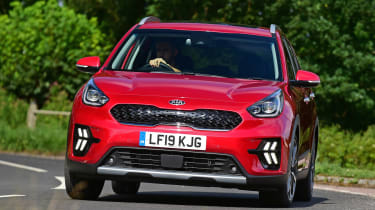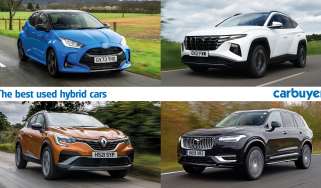Kia Niro SUV - MPG, running costs & CO2 (2016-2022)
Running costs for the hybrid aren't as impressive as a Toyota Prius, but the Kia Niro should prove cheap to live with
The Niro hybrid is impressively efficient compared to typical small crossover competitors such as the Nissan Juke, Mazda CX-3 and Renault Captur. Its figures are bettered by the Toyota Prius, but that is a family hatchback rather than a compact crossover after all.
Officially, you can travel for up to three miles on electric power alone, at speeds of up to 70mph, but in normal use the Niro will constantly flick between the petrol engine and the electric motor. The Niro is mostly intended to be used as a regular hybrid, with the electric motor acting to assist (and being recharged by) the conventionally fuelled engine. It kicks in reasonably smoothly and unobtrusively, making the Niro pleasant to drive.
The plug-in hybrid (PHEV) is a different kettle of fish, with a larger battery for an extended all-electric range of up to 30 miles. This gives it much better economy figures (over 200mpg is claimed), but it also increases its price significantly. If you can afford it, it’s a great halfway point between the regular hybrid and the more expensive, fully electric Kia e-Niro. It can also be a good solution if you often travel away from the charging network, or travel long distances on the motorway, as you don't have to charge the battery pack from the mains to keep going.
Kia Niro MPG & CO2
Claimed fuel economy for the entry-level hybrid is 58.9mpg and CO2 emissions are 110g/km – not low enough to earn exemption from the London Congestion Charge, but competitive when compared against the Toyota C-HR hybrid. As a hybrid that costs under £40,000 the Niro falls into the lower road tax band, with a £10 discount due to its status as an 'alternative fuel' car. It also boasts a company-car tax band which is lower than most diesel rivals, but higher than the Prius.
You’ll need to stick to the standard low-drag 16-inch alloy wheels if you want those figures, though: fitting the optional larger 18-inch rims by going for a higher-specification model bumps the CO2 number up to 119g/km and makes a dent in fuel economy, too. This just keeps it in a low-ish company-car tax bracket, although further options could push it into the next band.
More reviews
With a larger 8.6kWh lithium-ion battery pack, the Niro PHEV needs charging from a home or public mains supply to give you its full benefit. When full, it can provide up to 30 miles of fuel-free driving, boosting its claimed economy figure to 201.8mpg and cutting CO2 emissions to 31g/km. This helps it qualify for a low BiK band and London Congestion Charge exemption, even if the £2,500 Government grant is no longer available for plug-in hybrid vehicles.
Keep the battery pack topped up and drive only short journeys and you might use almost no fuel at all. Drive the Niro PHEV with no charge and it should still return around 55mpg, however, doing a good job acting as a conventional hybrid.
The Niro incorporates some clever technology to help you save fuel, such as ‘Predictive Energy Control’, which uses data from the sat nav to optimise the hybrid system, anticipating steep climbs or descents. It’s also been designed to be very aerodynamic and features some parts, such as the seats, that are lighter than their equivalents in normal cars.
Insurance group
The hybrid Niro falls into insurance group 11, 12 or 13, depending on whether you go for the 2, 3 or 4 specification. Opt for the PHEV and the groups rise to 14 or 15 for the 2 and 3 trims respectively. The pure-electric e-Niro, despite its relatively uncomplicated powertrain, posts much higher insurance groups – ranging from 20 to 27 depending on battery size and specification.
Warranty
In common with all other Kias, the Niro gets the brand’s seven-year/100,000-mile warranty. It’s one of the longest warranties out there, although the Hyundai Kona Hybrid and Toyota C-HR both come with generous five-year/unlimited-mileage cover.
Servicing
The Niro requires servicing every 10,000 miles or once a year, the same as most conventionally powered models in the Kia line-up. The brand offers a three-year servicing deal, costing around £450.
Which Is Best?
Cheapest
- Name1.6 GDi 127 Hybrid 2 Nav 5dr DCT
- Gearbox typeAuto
- RRP£30,085
Most Economical
- Name1.6 GDi 168 PHEV 2 5dr DCT
- Gearbox typeAuto
- RRP£35,325
Fastest
- Name1.6 GDi 168 PHEV 2 5dr DCT
- Gearbox typeAuto
- RRP£35,325










